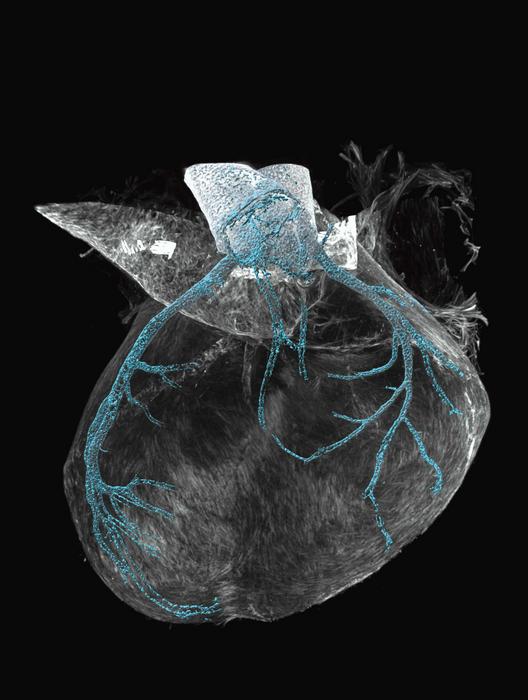A groundbreaking study led by Dr. Annette Hammes at the Max Delbrück Center for Molecular Medicine has unveiled a remarkable new dimension to the function of the PIEZO2 ion channel, traditionally known for its role in mechanosensation. Published in Nature Cardiovascular Research, the investigation reveals that PIEZO2 is not merely a mediator of touch stimuli but also a critical regulator in the formation and development of coronary vessels during embryogenesis. This discovery provides profound insights into the molecular underpinnings of congenital heart defects and opens new avenues for therapeutic innovation.
Ion channels like PIEZO2 have long fascinated scientists due to their exquisite sensitivity to mechanical forces. Embedded in the membranes of various cell types, PIEZO2 channels convert physical stimuli, such as pressure or stretch, into biological signals. These channels underlie our ability to perceive gentle breezes and even the faintest touches on the skin. However, Dr. Hammes and her team have demonstrated that PIEZO2’s functional repertoire extends into the realm of cardiovascular morphology, particularly within the developing heart’s vascular system.
Utilizing advanced mouse models genetically engineered to lack or overexpress PIEZO2 in endothelial cells, the research team meticulously charted the consequences of altered PIEZO2 activity on coronary artery development. Their findings were striking: in the absence of PIEZO2, coronary vessels often failed to mature properly, resulting in abnormally narrow or misbranched arteries. This vascular malformation compromised oxygen delivery to the heart muscle, instigating compensatory hypertrophy – a thickening of cardiac tissue primarily observable in the left ventricle. Conversely, mice harboring a hyperactive PIEZO2 variant displayed parallel defects, illuminating the finely tuned balance required for normal cardiovascular patterning.
.adsslot_WxMc1as2X4{ width:728px !important; height:90px !important; }
@media (max-width:1199px) { .adsslot_WxMc1as2X4{ width:468px !important; height:60px !important; } }
@media (max-width:767px) { .adsslot_WxMc1as2X4{ width:320px !important; height:50px !important; } }
ADVERTISEMENT
Technically, the researchers employed cutting-edge tissue clearing methods combined with light sheet microscopy to visualize coronary artery formation in unprecedented detail. By staining developing vessels with specific antibodies targeting PIEZO2-expressing endothelial cells, they captured high-resolution three-dimensional images demonstrating the spatial distribution and branching patterns of coronary arteries throughout embryonic stages. This approach facilitated an in-depth analysis of how altered ion channel signaling perturbs vascular architecture, bringing to light mechanisms that were previously invisible to conventional histological techniques.
A particularly intriguing aspect of PIEZO2 revealed by the study is its temporal expression pattern. The ion channel is predominantly active during embryogenesis within the endothelial cells of coronary arteries, orchestrating vascular formation before becoming largely silent after birth. However, emerging evidence suggests that PIEZO2 may be reactivated in adult hearts under pathological conditions, such as ischemic injury or coronary artery disease. This re-expression holds exciting therapeutic potential for promoting vascular regeneration and repair, positioning PIEZO2 as a candidate target for novel cardiovascular treatments.
Building on these preclinical insights, Dr. Hammes and colleagues are now extending their work to human models. Collaborations with the Helmholtz Institute for Translational AngioCardioScience and the Max Delbrück Center’s Pluripotent Stem Cell Technology Platform enable the use of human endothelial cells derived from pluripotent stem cells. This platform allows precise manipulation and observation of PIEZO2 expression and activity in human vascular cells, potentially bridging the translational gap between murine findings and clinical applications.
The research also prompts a reevaluation of the role of mechanosensation in cardiovascular biology. Traditionally associated with sensory neurons and touch perception, channels like PIEZO2 are now recognized as pivotal molecular transducers integrating mechanical forces during organogenesis. These forces guide cellular behavior, vascular remodeling, and tissue homeostasis in complex and dynamic ways, underscoring the interdisciplinary nature of modern cardiovascular research.
Crucially, the study spotlights the Max Delbrück Center’s unique collaborative environment, where multidisciplinary teams converge to tackle the intricacies of disease mechanisms. Contributions from labs specializing in molecular signaling, endothelial biology, and cardiac physiology collectively facilitated a comprehensive elucidation of PIEZO2’s role. This synergy exemplifies how integrating diverse expertise accelerates discovery and fosters innovation that can directly impact patient care.
Beyond the immediate cardiovascular implications, these findings may also influence related fields such as developmental biology, regenerative medicine, and genetic disease research. Understanding how mechanical forces are sensed at the molecular level to sculpt organ systems could inform strategies to engineer tissues or modulate cell behavior in various contexts, ultimately enhancing regenerative therapies.
In conclusion, the unveiling of PIEZO2 as a mechanosensitive ion channel essential to coronary artery development marks a paradigm shift in cardiovascular biology. This pioneering research by Dr. Hammes and her team not only deepens our comprehension of the molecular mechanisms governing heart formation but also opens new frontiers for diagnostic and therapeutic innovation aimed at combating congenital and acquired heart diseases. As investigations proceed into human models and adult cardiac pathology, PIEZO2 may emerge as a fate-shaping conduit between biomechanics and medicine.
Subject of Research: Animals
Article Title: Mechanosensitive PIEZO2 channels shape coronary artery development
News Publication Date: 27-Jun-2025
Web References:
Hammes lab: https://www.mdc-berlin.de/hammes
Lewin lab: https://www.mdc-berlin.de/lewin
Gerhardt lab: https://www.mdc-berlin.de/gerhardt
Hübner lab: https://www.mdc-berlin.de/huebner
Helmholtz Institute for Translational AngioCardioScience: https://www.mdc-berlin.de/hi-tac
Pluripotent Stem Cell Technology Platform: https://www.mdc-berlin.de/pluripotent-stem-cells
References:
DOI: http://dx.doi.org/10.1038/s44161-025-00677-3
Image Credits:
Mireia Pampols-Perez, Max Delbrück Center
Keywords:
PIEZO2, coronary artery development, mechanosensitive ion channels, congenital heart defects, endothelial cells, mechanotransduction, cardiac hypertrophy, vascular morphogenesis, Pluripotent Stem Cells, cardiovascular regeneration
Tags: advanced mouse models in researchcardiovascular morphologycongenital heart defectscoronary vessel formationDr. Annette Hammes studyearly heart developmentembryonic vascular developmentendothelial cell functionmechanosensation in cardiovascular systemmolecular mechanisms of heart developmentPIEZO2 ion channel researchtherapeutic innovation in cardiology





